Resource Management
-
- Fisheries Technology for Resource Management Marine Technology, May 2014 #36
The U.K. alone has 6,400 fishing vessels, with total landings of fish catch equating to $1.3 billion (627,000 tons) in 2012 (1). Despite warnings of a slowdown in the marine catch in the 1970s and 80s, the fishing industry increased fishing efforts with more powerful boats as well as superior technology, allowing the tracking of fish populations with sonar devices and larger nets to increase catch size. In addition, the international commercial fishing industry is double the size necessary to meet current requirements, and overcapacity is now a global norm. The European Union itself is in 40% overcapacity, resulting in fierce competition and difficulties in mitigating impacts with higher percentages found around the globe (2).
The Problem
Although overexploitation of fishing resources is the main issue, wasteful practices which resort in by-catch or discard is an area necessitating much focus by resource management schemes. By-catch has long been recognized as a widespread issue, with around 25% of total catch being discarded back into the sea dead due to little or no commercial value (3). This equates to approximately 27 million tons, the equivalent of 600 fully-laden Titanics (4).
The impact of by-catch to the ocean ecosystems is not only colossal but often irreversible (5). The different types of commercial fishing practices result in variations of species and quantities being killed as by-catch: nets kill cetaceans, long-line fishing kills birds and bottom trawling devastates marine ecosystems (5).
oShrimp fisheries are renowned to be inefficient and ecologically damaging, with often more than 80% of a catch comprising marine species other than shrimp which gets discarded (5). Bottom-trawling and beam-trawling, removes up to 20% of the seafloor fauna and flora in a single trawl, in addition to by-catch of commercially unattractive animals (5).
By-catch occurs due to fishing gears inability to adequately select target species, the problem worsened by economic pressures resulting from overexploitation (3). A large majority of by-catch is discarded due to fishing quotas minimizing landings (size of catch) and when regulatory restrictions prohibit retention of particular attributes (size, species, sex) (3, 5). Therefore, some by-catch occurs in commercial fisheries, however, higher rates are found in fisheries with less selective fishing methods and practices. Mitigating the environmental impact of commercial fishing by avoiding, minimizing and compensating for adverse effects, is fundamental for fisheries management authorities worldwide (6). The complex interplay of ecological, economic, and social considerations has often resulted in by-catch management being reactive, confrontational and costly (6). Some by-catch species, including fish, reptiles, birds and mammals, may be threatened with extinction (3). Even Tuna fisheries, which in the past had high dolphin by-catch levels, are still responsible for the deaths of an estimated one million sharks annually (5). Around the U.K., evidence of the growing scale of by-catch is washed up on beaches around the south west of England and northern France annually in the form of dolphin and porpoise corpses.
Progresses in technology for impact reduction has not been as quickly established as technologies designed to increase overall catch. Although modifications to fishing gear or practices have offered an effective means of reducing by-catch, such as turtle exclusion devices and Pingers, these devices need continual monitoring and in many cases it has been difficult to demonstrate success (3, 6). Therefore effective use of these devices depends on overcoming gear handling constraints and the short-term economic losses often associated with their use (3).
The Solution
The Icelandic high technology company Star-Oddi has developed revolutionary equipment that filters out the majority of unwanted by-catch, (up to 75% of the by-catch). The Fish Selector, which is an equipment that automatically separates the fish while still in the trawl, means that discarding of fish by fishing companies could be a thing of the past.
The aims of using Fish Selector are to increase the value of the catch, avoid discard of fish and increase fishing efficiency by helping with decision making for the skipper of selecting a fishing area. In addition to benefitting the commercial fisheries companies the marine research institutes may find scientific value in using the equipment in their studies.
The Fish Selector is placed in front of the cod-end and as the fish swim through the device it is pre-programmed to select fish by specific size and species so those that are not intended for landing, are sorted out and directed away through a bypass gate. Collected information is wirelessly monitored in real-time in the bridge on the quantity of fish caught, as well as quantity bypassed. Other data can be collected such as depth, temperature and inclination.
Data on how many fish are caught and how many are released is automatically stored and sent in real time onboard the vessel. Collected information on quantity of caught fish and bypassed fish can be viewed wirelessly by the crew. The data gives insight into the quality of the fishing ground so the skipper can quickly and better estimate if fishing should continue or if movement to a different area would be beneficial. The emphasis on responsible and sustainable fisheries has been increasing. Fishing companies using the Fish Selector can help in delivering the message to consumers that the company is making its contribution to sustainable fisheries by releasing threatened species.
Field Testing
In December 2010 the Fish Selector was tested on the research ship Drofn. It operated very well on its first sea trial. Since then, focus has been on reducing the size of the equipment which will give the fishermen the following advantages:
Takes less deck space
Smaller volume and weight decreases hazards associated with having bulky equipment on deck
Fishermen can more easily move the equipment around and the smaller device is then carried by two operatives
Smaller volume and lower weight will make it easier to take the device onto smaller ships, increasing the market potential
First Prize Innovation Award for the Fish Selector
Star-Oddi won first prize for the most innovative technology for the fishing industry at the Icelandic Fisheries Conference. The conference was held for the fourth time in November 2013. People from fishing companies, state officials and scientists attend this conference. The goal of the award is to encourage creative thinking and innovation in the fisheries sector.
About Star-Oddi
Star-Oddi (Iceland) develops research equipment for increasing the knowledge on marine life and underwater environments. Star-Oddi specializes in the design and manufacture of scientific equipment, mainly miniature data loggers containing microelectronics and sensors for monitoring behavioral and environmental parameters such as salinity, temperature, depth, tilt angle and more. The miniature self-contained loggers are used for behavioural studies of fish as well as on moorings and nets.
References
(1) Overview of the UK fishing Industry (2013). Retrieved from Marine Management Organization website: www.marinemanagement.org.uk/fisheries/statistics/annual.htm
(2) World Fisheries: Declines, Potential and Human Reliance (April, 2006). Retrieved from the University of Michigan website: www.globalchange.umich.edu/globalchange2/current/lectures/fisheries/fisheries.html
(3) Cook, R. (2003). The Magnitude and Impact of By-catch Mortality by Fishing Gear. In M. Sinclair & G. Valdimarsson (Eds.), FAO. Responsible Fisheries in the Marine Ecosystem.
(4) Threat 1: Overfishing (n.d.). Retrieved from Save Our Seas Foundation website: saveourseas.com/threats/overfishing
(5) Bycatch – wasteful and destructive fishing (n.d.). Retrieved from Greenpeace website: www.greenpeace.org.uk/oceans/problems/bycatch-wasteful-and-destructive-fishing
(6) Kirby, S.K., Ward, P. (2014). Standards for the effective management of fisheries bycatch. Marine Policy, 44, 419-426
(As published in the May 2014 edition of Marine Technology Reporter - http://www.marinetechnologynews.com/Magazine)
-
- USMMA: Teaching with Simulation in the Maritime Field Maritime Reporter, Oct 2020 #18
hand, are more aspirational and define what we intend to do when we set out at the beginning of a course. For example, an outcome for a Bridge Resource Management course might be to “demonstrate proper implementation of the rules of the road”; whereas the objective might be to “encounter
-
- SUNY Maritime: Bridging the Competency Gap Marine News, Jan 2015 #44
bridge simulators, instruction stations, and a de-briefing area, where instructors can discuss topics including navigation, seamanship and bridge resource management skills required in the operation of tugs and barges. According to Eric Johannson, SUNY Maritime’s Vice Chairman, Professional Education &
-
- Training to Prevent Marine Accidents & Deaths Maritime Reporter, Jun 2014 #62
assessment and incident investigation. Further, we have a number of courses that address the behavioral aspects of behavior-based safety, maritime resource management, leadership and team work.” He also points out that all these courses are incorporated in the recent revision of STCW 2010 where additional
-
- UPSCO Appoints George Geyer VPResource Mgmt/Admin Maritime Reporter, Nov 1981 #21
George W. Geyer has been appointed vice president of Resource Management and Administration of the Upper Peninsula Shipbuilding Company (UPSCO). UPSCO's facility in Ontonagon, Mich., specializes in the construction of tugs, barges, drydocks, and ships or other steel fabrication work. Mr. Geyer
-
- MariTel Launches New Marine Telephone Service With Vessel Location Maritime Reporter, Jul 2001 #36B
Network, scheduled for completion by the end of 2002. Built expressly for the maritime industry, the telecommunications network is a new marine resource management tool that employs internationally mandated Digital Selective Calling (DSC) technology. Upon completion of the network's 161 towers covering
-
- New Transas Liquid Cargo Handling Simulator Maritime Reporter, Apr 2014 #104
which requires adequate training to minimize the risks of damage to personnel, environment and assets. Transas LCHS 5000 allows for a complete resource management training involving crews of both mother and daughter vessels. www.transas.com (As published in the April 2014
-
- Transas Liquid Cargo Handling Simulator Maritime Reporter, May 2014 #55
which requires adequate training to minimize the risks of damage to personnel, environment and assets. Transas LCHS 5000 allows for a complete resource management training involving crews of both mother and daughter vessels. The LNG vessel and LNG terminal simulator models were developed in collaboration
-
- Maritime Simulation: High-tech Meets Practical Skills Maritime Reporter, Mar 2018 #57
has expanded over the years to include not only training for their employees, but also assessments of their mates and captains. This includes bridge resource management, engine resource management, candidate assessments and evaluations; all of these programs use our campus simulators. In addition, a multi-year
-
- Safe Cruising Down Under with Australian Reef Pilots Maritime Reporter, Feb 2016 #28
such as a one-week advanced pilot training course, a one-day helicopter underwater escape training (taken every four years), and a four-day bridge resource management course. The Torres Strait and Great Barrier Reef simulation program developed by ARP and Smartship Brisbane (an Australian simulation center)
-
- Resolve Installs New Engine Room Simulator Maritime Reporter, Jan 2014 #56
full mission bridge simulator, allowing integrated training options for a variety of courses. “Connecting the simulators means we can offer Resource Management and Integrated Systems training to our clients,” said David Boldt, Simulation Training Group Manager at Resolve Maritime Academy. Resolve
-
- World's First Full Mission Diesel Electric Simulator Debuts Maritime Reporter, Jan 2002 #49
High Voltage Room. The training can be specific in nature for equipment familiarization or more general when used for plant management or Engine Room Resource Management (ERM). Circle 198 on Reader Service Card www.maritimereporterinfo.co
-
 )
March 2024 - Marine Technology Reporter page: 45
)
March 2024 - Marine Technology Reporter page: 45ronments. The new agreement will address speci? c techni- cal gaps in the UUV defense and offshore energy markets especially for long duration, multi-payload mission opera- tions where communications are often denied or restricted. As part of the new alliance, Metron’s Resilient Mission Autonomy portfolio
-
 )
March 2024 - Marine Technology Reporter page: 30
)
March 2024 - Marine Technology Reporter page: 30tracks, and to further limit sediment disturbance, it has a Greg Stone, Chief Ocean Scientist. ? nes rejection system. Research conducted by Nauru Ocean Resources, a subsid- This type of technology was ? rst tested successfully in the iary of The Metals Company, found that organisms continue 1970s by major
-
 )
March 2024 - Marine Technology Reporter page: 25
)
March 2024 - Marine Technology Reporter page: 25on land.” • Shallow Gas Hazard Surveys • Oi shore Wind Turbine Phase two, mapping inside the caldera, • Geotechnical InvesO gaO on • Sand Resource InvesO gaO on featured SEA-KIT International’s USV Maxlimer and marked the ? rst time an uncrewed surface vessel had been used to survey the
-
 )
March 2024 - Marine Technology Reporter page: 19
)
March 2024 - Marine Technology Reporter page: 19About the Author vey with the pipe tracker is not required, resulting in signi? - Svenn Magen Wigen is a Cathodic Protection and corrosion control cant cost savings, mainly related to vessel charter. expert having worked across The major advantage of using FiGS on any type of subsea engineering, design
-
 )
March 2024 - Marine Technology Reporter page: 15
)
March 2024 - Marine Technology Reporter page: 15sensor options for longer mission periods. About the Author For glider users working in ? sheries and conservation, Shea Quinn is the Product Line Manager the Sentinel can run several high-energy passive and active of the Slocum Glider at Teledyne Webb acoustic sensors, on-board processing, and imaging
-
 )
March 2024 - Marine Technology Reporter page: 6
)
March 2024 - Marine Technology Reporter page: 6MTR Editorial Advisors Gallaudet Hardy The Honorable Tim Gallaudet, Kevin Hardy is President PhD, Rear Admiral, U.S. of Global Ocean Design, Navy (ret) is the CEO of creating components and Ocean STL Consulting and subsystems for unmanned host of The American Blue vehicles, following a career
-
 )
March 2024 - Marine Technology Reporter page: 2
)
March 2024 - Marine Technology Reporter page: 2the unknown in the wake of the Hunga Tonga– Hunga Ha’apai Eruption By Celia Konowe Subsea Mining 28 Nodule Collectors Tapping the sea ? oor for resources may be controversial, but it’s happening. y Wendy Laursen B 34 Lander Lab We Need More Power Stored electrical power in batteries permit the
-
 )
April 2024 - Maritime Reporter and Engineering News page: 39
)
April 2024 - Maritime Reporter and Engineering News page: 39Tech Files Latest Products, Systems and Ship Designs “Wall Climbing Robot” Danish Pilot calls gets ClassNK Nod LEGO Model "A tribute build to a work life at sea" Image courtesy MOL, Sumitomo Heavy Industries lassNK granted its Innovation Endorse- Image courtesy Espen Andersen/DanPilot ment for
-
 )
April 2024 - Maritime Reporter and Engineering News page: 35
)
April 2024 - Maritime Reporter and Engineering News page: 35SIMULATION e have a close relationship with tech- Realism is prized beyond immersive, photo-realistic visu- nology, evidenced by, for example, als, and providers are introducing increasingly accurate func- the phones we are estimated to un- tionality. FORCE Technology’s upcoming DEN-Mark2 math- lock around
-
 )
April 2024 - Maritime Reporter and Engineering News page: 27
)
April 2024 - Maritime Reporter and Engineering News page: 27RADM PHILIP SOBECK, MILITARY SEALIFT COMMAND With COVID, we had to make some hard choices for our Do your CIVMARs have upward mobility? mariners because we couldn’t rotate. Many of our mariners The Navy has Sailors who become “Mustangs,” and work found other employment, and were able to use their skills
-
 )
April 2024 - Maritime Reporter and Engineering News page: 25
)
April 2024 - Maritime Reporter and Engineering News page: 25and authorities that who know steam plants. I can say that we’re expending a lot span the entire Navy. I’m a “type commander,” responsible of resources to allow our older ships to continue to perform. for the “man, train and equip” function that generates forc- es for the combatant commanders around
-
 )
April 2024 - Maritime Reporter and Engineering News page: 14
)
April 2024 - Maritime Reporter and Engineering News page: 14Book Review Approach to Meeting Underwater Radiated Noise Limits Def ned By Raymond Fischer uantitative underwater radiated noise limits will construction inspections, 5) possible training with respect to be developed shortly by IMO, and/or countries salient design/construction essentials, 6) compliance
-
 )
April 2024 - Maritime Reporter and Engineering News page: 10
)
April 2024 - Maritime Reporter and Engineering News page: 10.0). This initiative, led selves with the new regime, by using the portfolio of train- Tby the Oil Companies International Marine Forum ing materials and resources from OCIMF, has been key to (OCIMF), heralds a new era in vessel inspection, compliance, ensuring stakeholders are well-equipped to navigate the
-
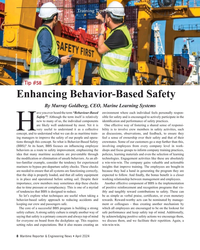 )
April 2024 - Maritime Reporter and Engineering News page: 8
)
April 2024 - Maritime Reporter and Engineering News page: 8Training Tips for Ships © By tuastockphoto/AdobeStock Tip #58 Enhancing Behavior-Based Safety By Murray Goldberg, CEO, Marine Learning Systems ave you ever heard the term “Behaviour-Based environment where each individual feels personally respon- Safety”? Although the term itself is relatively sible for
-
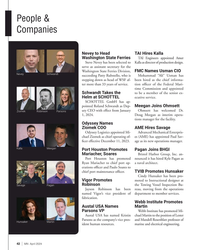 )
April 2024 - Marine News page: 42
)
April 2024 - Marine News page: 42Kristin chael Martin to the position of Lester Parsons as the company’s vice pres- and Mandell Rosenblatt professor of Hunsaker Martin ident human resources. marine and electrical engineering. 42 | MN April 202
-
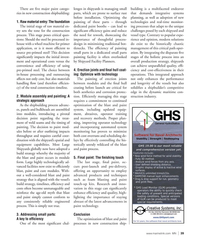 )
April 2024 - Marine News page: 39
)
April 2024 - Marine News page: 39There are ? ve major paint catego- lenges in shipyards is managing small building is a multifaceted endeavor ries in new construction shipbuilding: parts, which are prone to surface rust that demands integrative systems before installation. Optimizing the planning, as well as adoption of new 1.
-
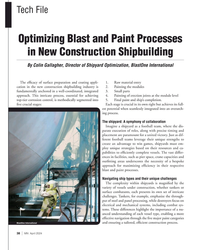 )
April 2024 - Marine News page: 38
)
April 2024 - Marine News page: 38dif- ferent football teams leverage their unique strengths to create an advantage to win games, shipyards must em- ploy unique strategies based on their resources and ca- pabilities to ef? ciently complete vessels. The vast differ- ences in facilities, such as pier space, crane capacities and out? tting
-
 )
April 2024 - Marine News page: 35
)
April 2024 - Marine News page: 35Capt. Josh Ferguson, master of the eWolf. Administration (MARAD), which all provided ? nancial support and other resources. “This tug becomes somewhat commercially viable be- cause of the grant process,” Manzi said. “Unlike a ferry service that’s paid for by tax dollars, we have to collect fares and
-
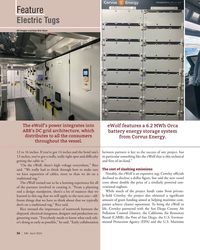 )
April 2024 - Marine News page: 34
)
April 2024 - Marine News page: 34stressed the importance of teamwork between the life, Crowley partnered with the San Diego County Air Pollution Control District, the California Air Resources shipyard, electrical integrator, designer and production en- Board (CARB), the Port of San Diego, the U.S. Environ- gineering team. “Everybody needs
-
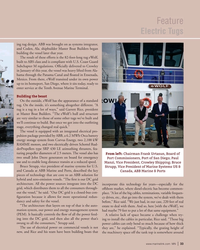 )
April 2024 - Marine News page: 33
)
April 2024 - Marine News page: 33Feature Electric Tugs ing tug design. ABB was brought on as systems integrator, and Coden, Ala. shipbuilder Master Boat Builders began building the vessel later that year. The result of these efforts is the 82-foot-long tug eWolf, built to ABS class and is compliant with U.S. Coast Guard Subchapter M
-
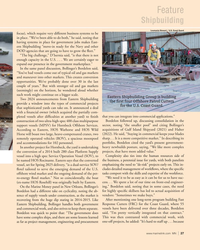 )
April 2024 - Marine News page: 27
)
April 2024 - Marine News page: 27Platform Supply projects, that have more added value.” vessel into a high spec Service Operation Vessel (SOV), to Complexity also ties into the human resources side of be named HOS Rocinante. Eastern says that the converted the business, a perennial issue for yards, with both panelists vessel, set for
-
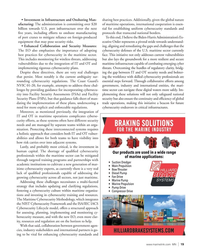 )
April 2024 - Marine News page: 19
)
April 2024 - Marine News page: 19updating and clarifying regulations, fostering a cybersecurity culture within maritime organiza- tions and investing in cybersecurity training and resources. The Maritime Cybersecurity Methodology, which integrates the NIST Cybersecurity Framework and the ISA/IEC IACS Cybersecurity Lifecycle model
-
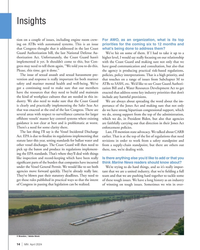 )
April 2024 - Marine News page: 14
)
April 2024 - Marine News page: 14well-being. We’ve ATBs to SASH, etc. We’d like to see Coast Guard Authori- got a continuing need to make sure that our members zation Bill and a Water Resources Development Act to get have the resources that they need to build and maintain enacted that address some key industry priorities that don’t the
-
 )
April 2024 - Marine News page: 13
)
April 2024 - Marine News page: 13really take that risk-based lens that We hope to see a Coast Guard Authorization Bill and we’ve talked about on cyber and other issues and make a Water Resources Development Act enacted this year. sure that it is tailored. There is a need on the regulatory side for some clari? ca- www.marinelink.com
